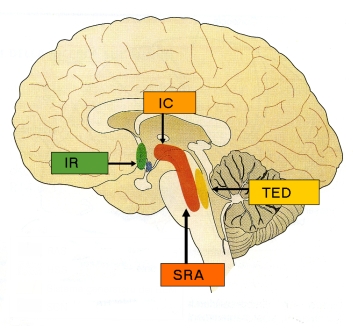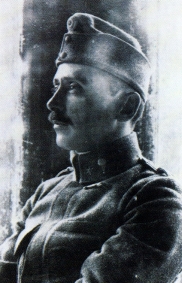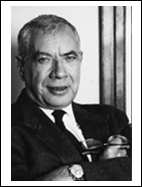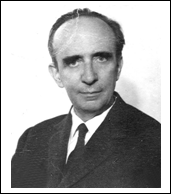Sleep and the brain
Sleep is a type of behaviour generated by mechanisms located in the central
nervous system. The nerve centres mainly held responsible for the physiological
signs of sleep are found in the
diencephalon![]() and in the
trunk of the encephalon
and in the
trunk of the encephalon![]() .
These structures form the deepest and, from an evolutionary point of view,
the oldest parts of the encephalon (fig. 1).
.
These structures form the deepest and, from an evolutionary point of view,
the oldest parts of the encephalon (fig. 1).
 Fig. 1: In the encephalon above we can see: a) ) the rostral part (IR) and the caudal part (IC) of the hypothalamus, a structure situated at the base of the part of the encephalon known as the diencephalon, b) the back part of the trunk of the encephalon (TED) and the sostanza reticolare attivante (SRA), which is located in the trunk of the encephalon and continues in the caudal hypothalamus. (Credit: G.Tononi, C.Cirelli. Sonno. In "Fisiologia Medica". Edi. Ermes., 2005.) |
It has been known for some time that sleepiness and insomnia in humans
can be caused by damage in the caudal (IC) and rostral (IR) parts of the
hypothalamus![]() respectively,
as observed by von Economo in patients affected by encephalitis following the
so-called "Spanish flu" pandemic.
respectively,
as observed by von Economo in patients affected by encephalitis following the
so-called "Spanish flu" pandemic.
|
|
|
|
|
|
On the other hand, movements characterised by REM sleep, such as muscular
hypotony![]() ,
sudden muscle contractions (mioclonie
,
sudden muscle contractions (mioclonie![]() )
and rapid eye movements, depend on the activity of nerve centres situated at
the back of the trunk of the encephalon
(TED).
)
and rapid eye movements, depend on the activity of nerve centres situated at
the back of the trunk of the encephalon
(TED).
The waking state, instead, is favoured by the activity of various
nerve centres distributed along the trunk of the encephalon, in a structure called the
sostanza reticolare attivante![]() (SRA), which extends up as far as the caudal hypothalamus (IC).
(SRA), which extends up as far as the caudal hypothalamus (IC).
The Webweavers: Last modified Mon, 6 Feb 2006 11:10:45 GMT


